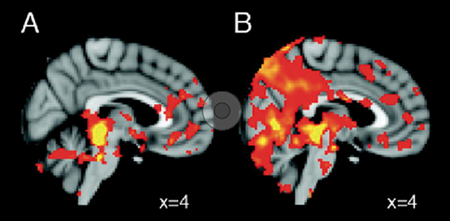https://doi.org/10.55788/a87e88c5
Dr Alicia Alpuente (Vall d'Hebron University Hospital, Spain) and colleagues set up a prospective observational study to measure salivary CGRP levels in healthy controls (HC; n=27), patients with episodic migraine (EM; n=27), and patients with chronic migraine (CM; n=16) [1]. This was done because it was still unknown whether there is a correlation between baseline CGRP levels and prediction of response to CGRP inhibitors, and to what extent and how CGRP levels are modified by this treatment. The participants collected saliva at baseline; those who were candidates for treatment with erenumab 140 mg also collected saliva after 3 doses of treatment. Saliva was collected with the resting unstimulated whole saliva method, at participants' homes. Three analyses were done: 1) baseline salivary CGRP levels in all 70 participants; 2) prediction of erenumab response from pre-treatment CGRP levels of 24 patients; 3) evaluate CGRP change after treatment in 23 patients.
The first analysis showed that headache frequency was associated with salivary CGRP levels, which were even higher in the case of depressive symptoms. Only in the CM group were baseline CGRP levels elevated in depressed patients. A cut-off value of 103.75 pg/mL could differentiate patients with migraine from HC, with 0.801 sensitivity and 0.916 specificity. The results of the second analysis showed that 10 patients (41.7%) responded to erenumab after 12 weeks. Higher pre-treatment salivary CGRP levels were statistically significantly associated with a higher probability of having a 50% or greater reduction in headache frequency in EM but not in CM patients. In the third analysis, salivary CGRP levels from migraine patients converged to similar CGRP values after 12 weeks of treatment with erenumab, regardless of migraine frequency. However, this was not the case in patients with concomitant depressive symptoms.
The authors concluded that CGRP can be measured reliably in the saliva of migraine patients. Patients with EM and CM have higher CGRP levels compared with HC. Depressive symptoms seem to increase salivary CGRP levels, creating a meaningful distinction between EM and CM patients. Baseline CGRP levels can be used to predict response to erenumab in non-chronic migraine patients. The heterogeneity of CGRP seems to be regulated and “normalised” by erenumab but not in depressed patients.
- Alpuente A. Salivary CGRP and erenumab response: towards precision medicine in migraine. Abstract A24, EHC 2022, 07–10 December, Vienna, Austria.
Copyright ©2022 Medicom Medical Publishers
Posted on
Previous Article
« Persistent headache after stroke: not rare and often overlooked Next Article
GWAS identifies 7 loci for cluster headache »
« Persistent headache after stroke: not rare and often overlooked Next Article
GWAS identifies 7 loci for cluster headache »
Table of Contents: EHC 2022
Featured articles
EHF consensus on effective migraine treatment and triptan failure
IHS President: “It is time for operationalisation of ICHD”
Headache Prophylaxis
Intervention
EHF consensus on effective migraine treatment and triptan failure
Sustained long-term effect of occipital nerve stimulation in MICCH
Onabotulinumtoxin A effective in older patients with chronic migraine
What to do when conventional treatment of headache fails in children
Predicting response to medical and surgical treatment of trigeminal neuralgia
Breakthroughs in Understanding Headache
IHS President: “It is time for operationalisation of ICHD”
GWAS identifies 7 loci for cluster headache
Towards precision medicine: salivary CGRP and erenumab response
Persistent headache after stroke: not rare and often overlooked
Additional effects of gepants on top of erenumab
Headache Prevention
Idiopathic intracranial hypertension: key factors influencing visual outcomes
Patients with migraines smoke less, drink less, and use fewer illicit drugs than general population
Related Articles

March 15, 2019
Central and peripheral mechanisms in migraine
October 27, 2020
Sustained shift in migraine status using galcanezumab
© 2024 Medicom Medical Publishers. All rights reserved. Terms and Conditions | Privacy Policy
HEAD OFFICE
Laarderhoogtweg 25
1101 EB Amsterdam
The Netherlands
T: +31 85 4012 560
E: publishers@medicom-publishers.com

